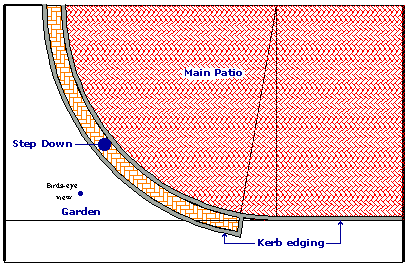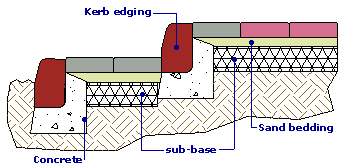As my garden is north facing I have decided to lay the main patio at the end of the garden with a smaller, matching patio adjacent to the house. The garden slopes away from the house and also from right to left.
It wasn't until I set the patio levels and excavated did I realise how much the garden sloped from right to left.
I now have a small problem. :( The sub-base levels of the left-hand edge (arcs) of the patios do not have anything to butt up to. I have a choice: build two small brick or concrete retainers high enough for the 100mm sub-bases? Which is best? And what footings would be best for these walls as the ground is clay. How thick should these retainers be and if concrete what ratio of sand or ballast to cement?
Thanks in anticipation...
New Patios on Sloping Garden
-
84-1093879891
Is it not possible to soil over the extended sub-base(s) once the paving is in place? This would be the simplest option, but, depending on your actual plan, I can appreciate that it's not always possible.
If you have to use retainer structures, try and keep it a simple as possible. Is there any way a flag-on-edge could be used in place of a wall? That's a much easier construction, as well as being cheaper and faster to construct.
However, if a wall is your only option, the height of the wall is the critical factor - for anything less than 450mm height, a simple double-skin wall of suitable bricks (Engineering brick are the best) laid on a 450x100mm foundation of C20 (or equivalent) concrete, with at least 150mm of frost cover, ought to do the job.
If you have to use retainer structures, try and keep it a simple as possible. Is there any way a flag-on-edge could be used in place of a wall? That's a much easier construction, as well as being cheaper and faster to construct.
However, if a wall is your only option, the height of the wall is the critical factor - for anything less than 450mm height, a simple double-skin wall of suitable bricks (Engineering brick are the best) laid on a 450x100mm foundation of C20 (or equivalent) concrete, with at least 150mm of frost cover, ought to do the job.
-
chrisevans
- Posts: 18
- Joined: Thu Aug 28, 2003 1:15 pm
- Location: Essex
Tony,
I have sent you a plan of the main patio via email in AutoCad .DWG format which I created in MS Visio to give you a clearer idea of the problem I have.
The void area between the excavation edge and the garden boundary I have filled with crush. But the more I look at this I don't think it will be strong enough to retain the DTP1 sub-base and may be prone to some movement long term.
The proposed retainer would only need to be 100mm in height to 'retain' the sub-base. Would this still require a 450mm deep :confused: C20 footing?
Thanks again....
I have sent you a plan of the main patio via email in AutoCad .DWG format which I created in MS Visio to give you a clearer idea of the problem I have.
The void area between the excavation edge and the garden boundary I have filled with crush. But the more I look at this I don't think it will be strong enough to retain the DTP1 sub-base and may be prone to some movement long term.
The proposed retainer would only need to be 100mm in height to 'retain' the sub-base. Would this still require a 450mm deep :confused: C20 footing?
Thanks again....
-
84-1093879891
I've 'coloured-in' your drawing and reproduce part of it here...

...for the benefit of other readers, the garden slopes from right to left, which is why the step down is needed at the end of the main patio.
Given that you've only 100mm or so to retain, I reckon this can be best done by using a large-size kerb unit, one that will give you 100-200mm of upstand, as shown in this cross-section....

...this form of construction acts as a retainer for the sub-base, as well as forming the riser for your steps. Where the garden level rises against the main patio as you near the house on the right hand side, this kerb can be progressively buried pr even omitted completely, if you prefer.
That seems to be the simplest solution to me. :)

...for the benefit of other readers, the garden slopes from right to left, which is why the step down is needed at the end of the main patio.
Given that you've only 100mm or so to retain, I reckon this can be best done by using a large-size kerb unit, one that will give you 100-200mm of upstand, as shown in this cross-section....

...this form of construction acts as a retainer for the sub-base, as well as forming the riser for your steps. Where the garden level rises against the main patio as you near the house on the right hand side, this kerb can be progressively buried pr even omitted completely, if you prefer.
That seems to be the simplest solution to me. :)
-
chrisevans
- Posts: 18
- Joined: Thu Aug 28, 2003 1:15 pm
- Location: Essex
:cool: This definitely resolves the problem!
I wouldn't need the step-down where the garden rises to the level of the patio but on the arc it would also be a nice decorative feature. If I assume your cross-section drawing is to scale the concrete footing for both kerb edgings would need to be 200mm deep? Also do you know if it is possible to buy curved kerb edgings (coloured?), with a radius of 300cms?
Thanks again...
I wouldn't need the step-down where the garden rises to the level of the patio but on the arc it would also be a nice decorative feature. If I assume your cross-section drawing is to scale the concrete footing for both kerb edgings would need to be 200mm deep? Also do you know if it is possible to buy curved kerb edgings (coloured?), with a radius of 300cms?
Thanks again...
-
84-1093879891
That drawing is "to scale" and the concrete foundation needs to be around 100mm thick, with 100mm of haunching at the back.
And the good news is that, although there are radial uniots available for making curved kerb lines, for one with a radius of 3m, you can get away with the standard units, which are significantly cheaper. You might want to mortar the joints: I think they look better when they're 'pointed' but some folk choose to leave them dry. Here's a an image of a 1.5m radius formed using standard kerb units (albeit in clay, rather than concrete, but the dimensions are exactly the same).....

...note how using a dark coloured mortar has emphasised the individual kerb elements, making them look asmart and attractive. :)
And the good news is that, although there are radial uniots available for making curved kerb lines, for one with a radius of 3m, you can get away with the standard units, which are significantly cheaper. You might want to mortar the joints: I think they look better when they're 'pointed' but some folk choose to leave them dry. Here's a an image of a 1.5m radius formed using standard kerb units (albeit in clay, rather than concrete, but the dimensions are exactly the same).....

...note how using a dark coloured mortar has emphasised the individual kerb elements, making them look asmart and attractive. :)